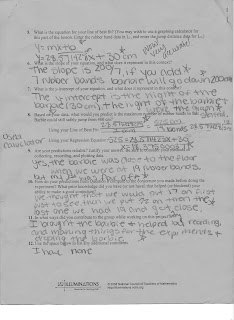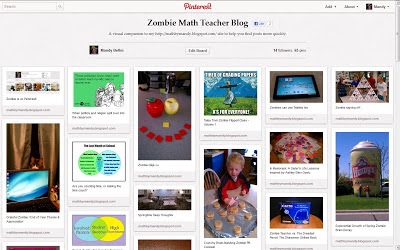Happy October!
We here in Minnesota seem to be teetering between late summer and an early winter with scarcely a fall day in sight. Maybe it's still to come. And maybe we'll actually hit 70 degrees tomorrow! (at any rate, I refuse to pull out my closed-toed shoes until there's snow on the ground)
I was looking at my blog stats and marveling at the wonder of Pinterest, in skyrocketing my "
Springtime Fun in Zombieland" post to #1 with over 1700 hits. I have not yet signed up for Pinterest, knowing that I will likely become instantly addicted... much as one avoids a fine bar of chocolate or bottle of fancy wine. But I would like to thank
Megan Wismer for the original pin that sparked the tide wave of interest in my PEMDAS foldable.
Several people have asked me what I put inside the flaps; and to them, I say, "to each student, his own". My suggestion is to have them put the basic rule and an example on the outer flap, and to use the work space underneath the flap to write down more examples that they'd likely screw up, that they need to practice. Don't overthink it. But I do find that doing things in a consistent color pattern, like rainbow order, helps with sanity.
Take this new math menu for example... We are on Chapter 3 and my students are finally getting into the rhythm of what Flip Class is, and are getting sick enough of my "how to take good notes" lectures that most are actually taking good notes...
I am maintaining consistency by color-coding EVERYTHING in the same manner for EVERY chapter, all year long (if I can afford to buy more of my favorite paper colors). That way, when students ask me what they should work on next, I can say, "choose from anything orange". And then they usually take the time to look at all the orange choices before deciding on a puzzle, or a reteaching sheet, or just doing the book problems listed.

Lesson 1 - pink
Lesson 2 - orange
Lesson 3 - yellow
Lesson 4 - green
Lesson 5 - light blue
Lesson 6 - teal
Lesson 7 - purple
Lesson 8 - brown
Lesson 9 - gray
Lesson 10 - cream
Projects - white
It feels like déjà vu reposting about
math menus, but I do feel the need to state how well homework menus work with
Flip Class. Students are loving having choices, and many are pushing themselves to try extra assignments, at higher levels of difficulty. They are doing more in their free time as well; simply because they want to, not because they have to. Yes, I give them extra credit for doing so, but honestly, when you have 110% in class already, what is the motivator for doing more work, other than to prove that you
can? (the record of 126% still stands from 2 years ago)
Student Questions:
-what do I write in my notebook when I'm reading my flip lesson?
Summarize and add pictures, copy down important rules & vocab, use highlighter, colors, and write down any answer checks you do. Star it if you solved it correctly on your own!
-how do I take notes on an example without just copying down exactly what I read?
Cover up the example and try each step on your own, then reveal. Write down your way if you liked it better, or questions that came up, or both ways if you're not sure, or if you don't get it. This works for Video Tutor as well: pause the video at the first step and work out as much as you can on your own; then hit "play" and see how the video did it, compared to your way. Were you right?
-when do I give up on the book, and switch to the video tutor?
This drives me CRAZY. Kids getting online and saying "I don't get it!"... well, I ask them... did you TRY the example on your own before looking at the book's method? Did you actually read the description? Did you hop online or onto Schoology and ask for help? Because I'd be happy to explain it to you another way, just text me! (yes, they have my cell #) Still no answer? THEN try the video tutor. Or maybe you should just do that first. Kay? You can always fast-forward the video tutor, or skip to the next step. You can't do that to me in class, as much as you'd like to.
-where do I go to get help if I get stuck on a math problem? (at home or in class)
PLEASE try to get help the night before from a study buddy, or from ME, or from the video tutor or your parents. You can at least write down the steps to the problem that you think are right, with question marks of where you got stuck.
-when is it OK to ask the teacher for help, vs. when ask my friends or work on my own?
This is another continuing battle. We are still struggling with "reading for meaning"; especially, how to read a lesson and understand the examples provided, and how they relate to the math rule being taught in the lesson. The "I don't get it" comment drives this Zombie absolutely batty. "You don't get it YET"... I throw back at them; wise words from my amazing coworker/mentor/friend.
-what is the difference between comparing answers, and copying answers?
Students are not allowed to ask "what did you get?" until all parties have worked out the whole problem and gotten to an answer, or have some work done and are stuck on a particular step. I love this because they often get into arguments about who is right, and then I come by to assist, and reward the winner, and everyone else goes "AAAAAAAAAAAAH! I get it NOW!"
-how to ask for easier/harder/independent work and when to ask
I was hoping to utilize our wonderful textbook as much as possible to save trees. But the reality is, the lowest students need a summary/reteaching worksheet often instead of the book flip lesson. It takes out the wordy description and just gives the rule with a few examples, and then scaffolds them through a few problems. Everyone else does the normal flip (listed on the menu above). THEN the real fun begins.
Work time rolls around (they usually have 40-50 minutes per day) and students can pick between the book assignment, a standard level worksheet, a harder worksheet, a challenge worksheet, a brain teaser puzzle, a problem-solving worksheet, or a real-world project. These don't have to be finished before they leave; they simply pick them back up the next day and continue where they left off. Pre-test scores are used to determine how many points students must earn to complete the menu (purple/standard might do 20 points, where gold/advanced would do 30 points or higher) and they MUST pick something from each lesson.
My Teacher Questions:
-how to pull students into needs-based groups without embarrassing them
Stop worrying about embarrassing them. They know exactly who is low at math and who needs more help. If it's that big of a deal, grab individuals from their desk in groups of 2-3 instead of 5-8 or seat them together on purpose near the front so you can touch base more often.
-how much whole-group instruction and review of "flip" notes is needed each day
Their attention span seems to wane after 10 minutes. We are spoiled rotten with 75-minute math periods, so I do a warm-up or an exploration for 10 minutes while I check in with each student on flip-lesson completion. Once I've circulated to everybody, we go over the intro activity for ~5 minutes, and then we go over our flip lesson & check guided practice answers for another 10 minutes, and then 50-minutes of work time begins. If I had shorter classes, I'd do less of a warm-up or use flip problems FOR my warm-up.
-how to keep students on task without sitting next to them
Still working on this one. This is so tough for 7th grade but I will not give up on them. I am probably kidding myself that they were doing anything more productive during my 40-minute lectures in previous years, than they do during their 50-minute work time. Maybe we need to add more stretch breaks or I need to make work groups in pairs or triads instead of quads. Will advise...
-how to get students to ask for and/or admit they need help or don't get it
Still working on this as well. Lecturing the class at large a LOT that they have GOT to be vocal if they need help. I can only bop around to each group once or twice per hour, so if they need more help than that, they must seek ME out. Or I will have to pull them for small group instruction!
-how many opportunities do I give to reteach/re-assess a concept before moving on
I need to do more of this. I am still in rushing racing zombie mode and trying to get through things too fast. There are always projects that the high kids can do while the low kids take more time to master the basics. SLOW DOWN, silly zombie and smell the roses!!!
-what to do with off-task students or those who don't have flip lesson done
Time for parent interventions, missing assignment messenger, and assigning a reteaching worksheet. Keep telling yourself, they were off-task just as much before flip-class; you just didn't notice because you were too busy lecturing to the whole class to notice their eye-wandering and their note-passing and their pencil-shredding.
-when to assign the class work as homework for off-task students
This has happened to 10% or so students from each class by now. I give them a warning, and usually an extra day, possibly with a few less problems to do... and if they still don't get it done and corrected and turned in, I make them take it home. Usually on a catch-up night or over the weekend when no one else has homework. (or they just don't do it and then they get a zero, just like they did before!)
-when and how much to reduce the class work for slower paced learners
I have resorted to letting them pick even or odd problems, and really focus on taking their time on those problems. They almost always choose a reteaching worksheet over carrying the book home, and do a basic worksheet in class for work time. I remind them that they are missing out on the cumulative review at the end of each lesson, so I have added the review as a separate choice on the new menu for a single point (rather than a daily requirement, they might do review twice a week, which is better than none at all). The whole point is to GET them to WANT to do work and to OWN up to their CHOICES.
-when to use the book and when to use worksheets (I waste so many trees!!!!)
Sorry trees. This generation likes worksheets. I've tried enabling the "drop box" feature on Schoology to electronically submit assignments, but until touch pads and styluses (sp?) become more user-friendly, and iPads/tablets drop in price, I doubt many will choose this route.
-how to use online assessment tools, versus paper, to demonstrate mastery
I gave my first electronic quiz on Schoology while I was at a conference. I solved the cheating problem by activating the "automatic answer sort" and "random question order" buttons so every kid had a different question with different answer orders on their screen. It gave me automatic feedback to the point that I was able to pull students for small-group instruction the NEXT DAY for those who needed it.
The unit test is still pencil-and-paper for now, though I allow all tests to be open note. Honestly, who needs to memorize ANYTHING anymore? Even the state and national tests allow a formula sheet. Who doesn't whip out their phone every two seconds these days to "google" or "mapquest" or check Wikipedia? I'm probably too lenient for most people, but I don't see the point in making kids cram their entire chapter's worth of notes onto a single sheet to bring in... maybe if they were able to type them... but that's hard to do with math pictures and formulas and symbols.
Hopefully that helps you all out there in Math land... if you've made it this far, I'm guessing you're trying the same things as me; otherwise you're probably BORED out of your MIND right now :o)
Have a great week and I'll post again once I have data on our first unit test tomorrow!!
-Zombie out































